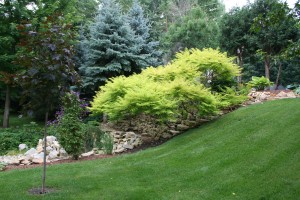How Big? Planting the Right Size Shrubs

It’s happened to many gardeners and homeowners. You plant a trio of cute little shrubs in front of your house. Three years later, you’re hacking your way through the brush to get to the door. What happened? Nothing. You’re shrubs just grew to their intended size, and like children that go from pint-sized to six-footers in a flash, it seems to happen overnight.
When planning a landscape one of the most important considerations is the mature size of the shrubs, trees and perennials. Choosing the right-sized plant from the outset will save time and labor later because you will not have to prune as often or as much. Allowing enough room for plants to reach their natural size and shape also will ensure that your landscape design looks attractive longer. Oversized shrubs can obscure the house or create an unintended focal point in the landscape. In addition, plants that have enough room around them for air-flow are less likely to succumb to disease.
Some typical shrubs chosen for home landscapes are naturally large. For instance, the American highbush cranberry (Viburnum trilobum)—a wonderful shrub with four-season interest that is rock-solid hardy in Minnesota and great for attracting birds—can get huge. This plant tops out at about 10-feet tall by 8-feet wide. That’s a nice size for a hedge on a large property, but probably too big for a foundation planting on a typical urban lot. A better choice might be one of the mid-sized or smaller weigela, such as Samba weigela (3-by-3 feet), or the Autumn Magic black chokeberry (Aronia melanocarpa ‘Autumn Magic’), which has similar multiseason interest and gets only about 5 feet tall.
Plant breeders are offering more and more shrubs and trees designed for smaller lots. For instance, Minnesota-based Bailey Nurseries Inc. helped introduce the Technito arborvitae (Thuja occidentalis ‘Bail John’). Technito was discovered about 20 years ago in a field of Techny arborvitae. Unlike its 30-by-15 foot relatives, this evergreen only grew about 6 feet tall and less than 3 feet wide, perfect for many home landscapes.
Finding out the eventual size of your shrubs, trees and perennials is easy. Read the plant tag and then ask a local nursery professional. The tag will give you a good idea of the eventual size—keep in mind both height and spread. But plants can get bigger or (more likely in our climate) stay smaller depending on the microclimate in which they are planted. Local nursery professionals will be able to tell you how well a plant will do in a specific situation.
While this post has dealt mostly with shrubs, the same considerations apply to trees and perennials. Fast-growing trees can change the amount of sunlight your gardens receive as they get bigger and their expanding root systems can affect how well grass and other plants grow under them. Perennials planted too close together are especially susceptible to fungus diseases.
Like kids, plants need plenty of room to grow.
